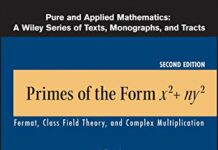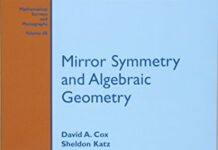
Ebook Info
- Published: 2005
- Number of pages: 587 pages
- Format: PDF
- File Size: 3.92 MB
- Authors: David A. Cox
Description
The discovery of new algorithms for dealing with polynomial equations, and their implementation on fast, inexpensive computers, has revolutionized algebraic geometry and led to exciting new applications in the field. This book details many uses of algebraic geometry and highlights recent applications of Grobner bases and resultants. This edition contains two new sections, a new chapter, updated references and many minor improvements throughout.
User’s Reviews
Editorial Reviews: Review From the reviews of the second edition: “The book has been very successful. It succeeded in establishing a bridge between modern computer science and classical algebraic geometry.” (Gerhard Pfister, Zentralblatt MATH, Vol. 1079, 2006) “The authors a ] do not expect much from their reader in terms of mathematical prerequisites. a ] This reviewer thinks that the part of the intended audience consisting of graduate students interested in research in computational algebraic geometry will find this to be a very useful book. The many exercises throughout the text, and the mere fact that this is a very good and detailed overview of the subject will definitely make it desirable for this group.” (Gizem Karaali, MathDL, September, 2005) From the Back Cover In recent years, the discovery of new algorithms for dealing with polynomial equations, coupled with their implementation on fast inexpensive computers, has sparked a minor revolution in the study and practice of algebraic geometry. These algorithmic methods have also given rise to some exciting new applications of algebraic geometry. This book illustrates the many uses of algebraic geometry, highlighting some of the more recent applications of Gröbner bases and resultants.The book is written for nonspecialists and for readers with a diverse range of backgrounds. It assumes knowledge of the material covered in a standard undergraduate course in abstract algebra, and it would help to have some previous exposure to Gröbner bases. The book does not assume the reader is familiar with more advanced concepts such as modules.For the new edition, the authors have added a unified discussion of how matrices can be used to specify monomial orders; a revised presentation of the Mora normal form algorithm; two sections discussing the Gröbner fan of an ideal and the Gröbner Walk basis conversion algorithm; and a new chapter on the theory of order domains, associated codes, and the Berlekamp-Massey-Sakata decoding algorithm. They have also updated the references, improved some of the proofs, and corrected typographical errors.David Cox is Professor of Mathematics at Amherst College. John Little is Professor of Mathematics at College of the Holy Cross. Donal O’Shea is the Elizabeth T. Kennan Professor of Mathematics and Dean of Faculty at Mt. Holyoke College. These authors also co-wrote the immensely successful book, Ideals, Varieties, and Algorithms.
Reviews from Amazon users which were colected at the time this book was published on the website:
⭐ok
⭐The authors are sticklers for accuracy, and this Second Edition looks sharp, covers a great deal, comes up to use of tools in Computational Algebra to the second or third wave (more than thirty years of Maple for example). The authors do justice to “theory” but do not get bogged down in excessively abstract formulations.
⭐Once thought to be high-brow estoeric mathematics, algebraic geometry is now finding applications in a myriad of different areas, such as cryptography, coding algorithms, and computer graphics. This book gives an overview of some of the techniques involved when applying algebraic geometry. The authors gear the discussion to those who are attempting to write computer code to solve polynomial equations and thus the first few chapters cover the algebraic structure of ideals in polynomial rings and Grobner basis algorithms. The reader is expected to have a fairly good background in undergraduate algebra in order to read this book, but the authors do give an introduction to algebra in the first chapter. Many exercises permeate the text, some of which are quite useful in testing the reader’s understanding. The Maple symbolic programming language is used to illustrate the main algorithms, and I think effectively so. The authors do mention other packages such as Axiom, Mathematica, Macauley, and REDUCE to do the calculations. The chapter on local rings is the most well-written in the book, as the idea of a local ring is made very concrete in their discussion and in the examples. The strategy of studying properties of a variety via the study of functions on the variety is illustrated nicely with an example of a circle of radius one. Later, in a chapter on free resolutions, the authors discuss the Hilbert function and give a very instructive example of its calculation, that of a twisted cubic in three-dimensional space. They mention the conjecture on graded resolutions of ideals of canonical curves and refer the reader to the literature for more information. Particularly interesting is the chapter on polytopes, where toric varieties are introduced. The authors motivate nicely how some of the more abstract constructions in this subject, such as the Chow ring and the Veronese map, arise. The important subject of homotopy continuation methods is discussed, and this is helpful since these methods have taken on major applications in recent years. In optimization theory, they serve as a kind of generalization of the gradient methods, but do not have the convergence to local minima problems so characteristic of these methods. In addition, one can use homotopy continuation methods to get a computational handle on the Schubert calculus, namely, the problem of finding explicity the number of m-planes that meet a set of linear subspaces in general position. There are some software packages developed in the academic environment that deal with homotopy continuation, such as “Continuum”, which is a projective approach based on Bezout’s theorem; and “PHC”, which is based on Bernstein’s theorem, the latter of which the authors treat in detail in the book. My primary reason for purchasing the book was mainly the last chapter on algebraic coding theory. The authors do give an effective presentation of the concepts, including error-correcting codes, but I was disappointed in not finding a treatment of the soft-decision problem in Reed-Solomon codes. In general this is a good book and worth reading, if one needs an introduction to the areas covered. Students could definitely benefit from its perusal.
⭐I just completed a course that used this book as a…reference. Granted, it is a first edition, but it reads like a rough draft. The presence of three authors is all too obvious in the inconsistent writing of proofs, paragraphs, and even exercises. Some proofs are just plain wrong, and many have gaping holes in them. Notation is confusing, and changes without warning or explanation. I will say this much in its favor: many important results are presented, although the proofs are absent. It makes a good source for named theorems, but that’s about it.
⭐ceci n’est pas un commentaire contre le livre (je ne l’ai pas encore commencé), mais contre amazon et la boutique kindle.En effet, ce livre n’est pas lisible sur une liseuse kindle … et ça n’est pas le premier que j’achète qui est de cette sorte.Et rien n’est indiqué sur la page du livre :((Il s’agit d’une espèce de format pdf (?) dont on ne peut pas changer la taille de police et qui présente pas non plus les autres avantages du livre électronique.Le précédent livre que j’ai acheté qui présentait ce caractère coûtait moins de trois euros, difficile de se plaindre pour ce prix,mais ici, c’est à peine moins que le prix du livre physique (contrairement à ce qui est indiqué sur la boutique kindle d’ailleurs).Bref, je suis modérément satisfait de ce procédé (c’est un euphémisme) .
⭐
Keywords
Free Download Using Algebraic Geometry (Graduate Texts in Mathematics, 185) 2nd Edition in PDF format
Using Algebraic Geometry (Graduate Texts in Mathematics, 185) 2nd Edition PDF Free Download
Download Using Algebraic Geometry (Graduate Texts in Mathematics, 185) 2nd Edition 2005 PDF Free
Using Algebraic Geometry (Graduate Texts in Mathematics, 185) 2nd Edition 2005 PDF Free Download
Download Using Algebraic Geometry (Graduate Texts in Mathematics, 185) 2nd Edition PDF
Free Download Ebook Using Algebraic Geometry (Graduate Texts in Mathematics, 185) 2nd Edition


